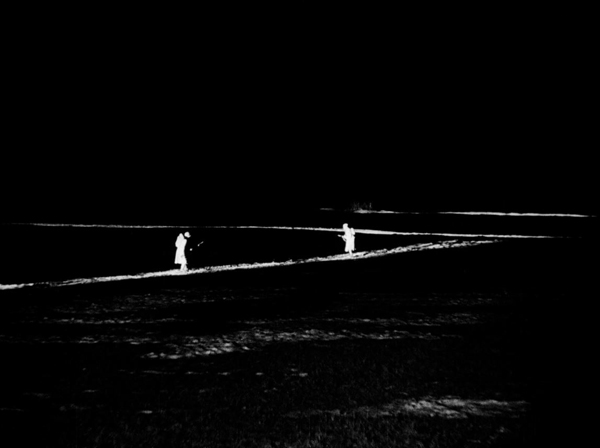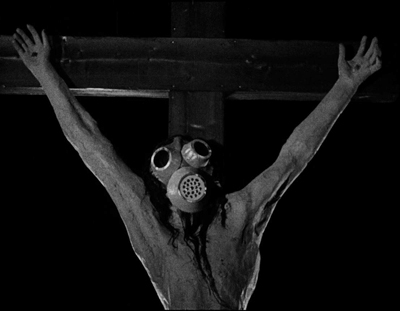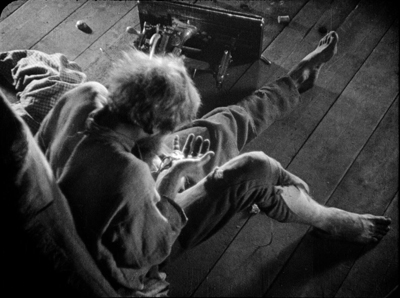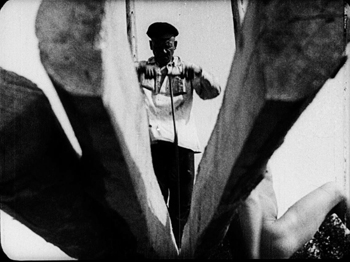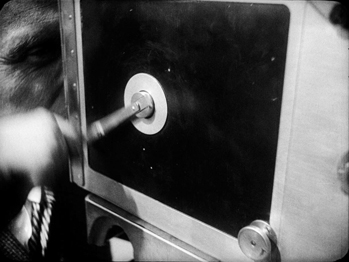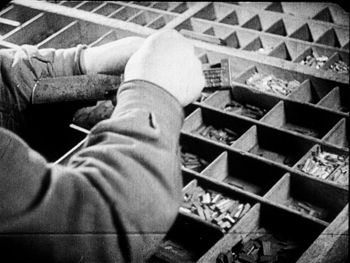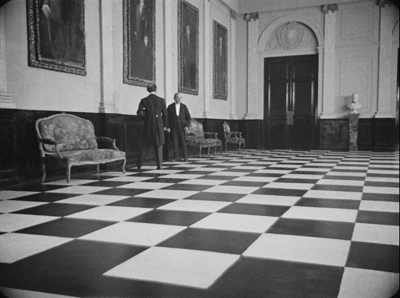Archive for August 2019
Two more classics from Flicker Alley
Fragment of an Empire (1928).
Kristin here:
Our friends at Flicker Alley have once again provided access to major works of silent cinema with two Blu-ray releases: Marcel L’Herbier’s L’Argent (1928) and Fridrikh Ermler’s Fragment of an Empire (1929).
Fragment of an Empire
When I was in graduate school, back in the 1970s, Ermler’s Fragment of an Empire (more accurately translated as “Remnant of an Empire”) was considered one of the major examples of Soviet Montage cinema. Its place in the canon seems to have faded since then, but this Blu-ray should restore its reputation.
Earlier prints of its were dicey. Its most famous scene was one in which the protagonist approaches a life-size crucifix at night on a battlefield and discovers that the head has been fitted with a gas-mask. David remembers seeing a print in which this image was present. I remember watching the film, expecting to see this image and being disappointed that it was not there. (I expected it because most histories of cinema that mentioned Fragment would use a production still of the crucifix.) Why the shots of the crucifix were removed is not clear, though presumably in countries where religious groups had some say in censorship matters, they were removed as blasphemous.
Peter Bagrov, formerly of the Gosfilmofond archive in Russia and now Curator of the Moving Image Department at George Eastman Museum, was centrally involved in the film’s restoration and provides the essays in the accompanying booklet. According to him, nine prints of the film from archives around the world were examined for this restoration. Only two of them contained the gas-mask Christ shots, one of them being the Museum of Modern Art’s distribution print. David probably saw that. I saw another version; I don’t recall when or where. Bagrov suggests that some prints that circulated as the “canonical” version of the film were in fact an abridged, simplified version made at the time for circulation to the uneducated rural population. Now we can all see something very close to the full original 1929 copies.
The film’s title refers to Filimonov, who is initially suffering from amnesia and working as a hired hand for a peasant woman at a remote stop on a rail line. Seeing a woman on a passing train triggers his memory, and he realizes that she is his wife and that he was a non-commissioned officer during the World War I. Going home to St. Petersburg, now Leningrad, he is shocked by the modern architecture and short skirts, as well as the fact that the owner of the textile factory where he had worked is no longer the master there. He gets a job at the same factory. Who, he repeatedly asks his fellow workers, is the master?
Fragment of an Empire falls into the common Soviet plot pattern of following a character who at first resists or ignores the revolutionary changes in the USSR but comes to understand and support them by the end. It also falls into the “Rip Van Winkle” pattern of a character who, either through amnesia or some fantastical time warp, is thrown into a society that has moved ahead without him or her. It’s a convenient way of defamiliarizing, as the Russian Formalists would say, that new society.
The opening third or so of the film is its most impressive portion. Several early segments take place at night on the bleak, flat land around the train tracks. Ermler makes impressive use of the new arc searchlights that had been developed for surveillance during the war. These intensely bright lamps made shooting in exteriors at night practical for the first time. Ermler created stark, white strips of light against pitch black, picking out individuals from a great distance (see top). The effect at times resembles some of the abstract experimental shorts of the 1920s.
In the opening scene, the bodies of soldiers who have died of typhus are heaped on a train platform to be buried. The peasant woman orders Filimonov to strip them of their boots, but while doing so he finds one wounded soldier still barely alive and saves him. The second sequence has Filimonov spotting his wife and beginning to piece together his memories. Back at home, more reminders trigger a series of quick flashbacks: a sewing-machine’s crank leads to a machine-gun firing, a rolling spool recalls wheels of trains and tanks. A somewhat more extended flashback involves a tank advancing on a soldier as he prays and begs for help from the gas-mask-outfitted crucifix before being crushed–a traumatic scene presumably witnessed by Filimonov, though he is not shown. Through much of the extended recovery Ermler employs the extremely short shots, graphic conflict, and dynamic angles (below) typical of Soviet Montage filmmaking.
Perhaps inevitably, once Filimonov has fully regained his memory and gone to Leningrad, the film becomes more conventional. For a while he wanders about, simply staring and commenting in confusion and disbelief at the modern buildings and people he sees. His hiring at the factory and misunderstanding about who is master there generates some humor as the other workers tease him–in a comradely way, of course. As they explain the new egalitarian society to him, Ermler launches the longest and most varied “work is glorious” montage sequence I have ever seen in a Soviet film of the era, with joyous workers wielding everything from saws to microscopes and, yes, movie cameras.
There is also a brief but amusing scene in which Filimonov takes his old tzarist war medal to donate it to a collection of theatrical props. The bizarre objects in this little warehouse recall the decadent ones Eisenstein uses to characterize the tsar’s quarters in the previous year’s October. This scene, along with much of the motif of Filimonov’s medal, was also eliminated from the “village” version. The intertitles restored in Russian with the original graphic layouts of the original, so that when Filimonov’s repeatedly cries “Who?” when he asks who the master of the factory is, the word changes size and position on the black background from title to title. (There are English subtitles throughout.)
One praiseworthy decision made by the restorers was to leave in the lines of the splices.
These splice-lines are of use to the historian and analyst. Watching a 35mm print on an editing machine, one can examine these directly on the filmstrip. The temptation to “clean up” the images to look pure and attractive, however, too often leads to their elimination. They are part of the original film and should always be left as is.
The Flicker Alley disc is NTSC but without region coding.
L’Argent
Marcel L’Herbier, though not one of my favorite directors, even of the silent period, was a major French director and has appeared on this blog a number of times. I included films by him in my annual list of the ten best films of ninety years ago: El Dorado for 1921 and L’Argent itself for 1928. Flicker Alley has been particularly kind to L’Herbier, and I have discussed their releases of his L’Inhumaine and Feu Mathias Pascal. Having summarized the importance and style of L’Argent in the 1928 post, I’ll concentrate here on the restorations and supplements of the existing discs.
This is the third restoration of L’Argent. The original negative and a finegrain positive made from it survive. In 1971 a restoration was done from this material, but someone made the unwise decision to step-print the new version to simulate the 16 frames-per-second shooting/projection speed of silent cinema. In fact, by the early 1920s the speed of the majority of films was up to around 20 fps, and by the late 1920s, it had reached nearly the same as sound films, around 24 fps. The resulting print of L’Argent, already quite a long film for its day, was off-putting indeed.
A 1994 restoration removed the step-printing and produced a version of excellent visual quality; it provided the basis for the “Masters of Cinema” two-disc DVD set from British company Eureka!, released in 2008. My discussion of L’Argent in the ten best of 1928 included frames from that version, which is no longer in print. It has not been released in a Blu-ray edition.
The third restoration, done by Lobster Films in 2018, forms the basis for the new Flicker Alley Blu-ray disc. (The ongoing cooperation between the two companies has made possible many of Flicker Alley’s discs of splendid copies of hitherto rare or inaccessible silent films.) The original camera negative was scanned in 4K for this new version.
Those who do not own the Eureka! set should welcome the renewed availability of this major film, perhaps L’Herbier’s finest.
Although there is some overlap between the supplements on these two releases, there are also significant differences. Both Eureka! and Flicker Alley include include a 40-minute documentary, Jean Dréville’s Autour de L’Argent (“About L’Argent,” 1928), an elaborate early “making-of” docmentary. Eureka! also offered a 54-minute 2007 documentary, Marcel L’Herbier: Poet of the silent cinema, not in the Flicker Alley release.
Flicker Alley, however, has two items not in the earlier Eureka! set. One is a five-minute short in which Serge Bromberg discusses “The Two Restorations of Auteur de L’Argent“, the Dréville documentary. More importantly, the other is a previously unavailable film, Prometheus Banker (Prométhée banquier). L’Herbier made this 16-minute short in 1921, apparently based very loosely on Zola’s novel, L’Argent. In retrospect, it looks like a brief sketch for the feature-length L’Argent, though it works as a one-reeler. It features L’Herbier’s familiar actors of the early 1920s: Eve Francis as the banker’s lover who longs to return to her happier, humbler beginnings (see below), Jacqe Catelain as the banker’s secretary, and Marcelle Pradot as the jealous typist. Apart from being an interesting early Impressionist film in itself, it provides a useful contrast in styles between similar stories told in 1921 and 1928 by the same director.
Neither the Eureka! release nor the Flicker Alley one has a commentary track. The Eureka! booklet is 78 pages long, with a lengthy essay by Richard Abel and a 1968 interview with L’Herbier, as well as some 1929 reviews of L’Argent. The Flicker Alley booklet is 23 pages, with essays by Mirielle Beaulieu.
According to the box and the film’s webpage, L’Argent is A/B/C, i.e., all regions (though the disc itself is marked A). It is presumably NTSC.
Many blog entries have discussed the Soviet Montage style; see this category. For more on French Impressionist cinema, see Scorsese, ‘pressionist and An old-fashioned, sentimental avant-garde film. We provide background on the two movements in Chapters 4 and 6 of Film History: An Introduction.
September 1, 2020: The Fragment of an Empire release has won The Peter von Bagh Award at the 2020 Il Cinema Ritrovato DVD Publishing Awards.
Prométhée banquier (1921)












